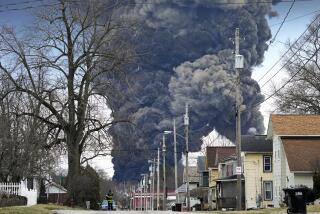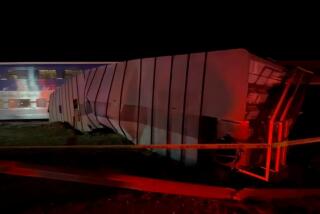Crew of Runaway Train Recalls Details of Fatal Derailment in May
- Share via
SAN BERNARDINO — A “helper engineer” riding in the back of a train that derailed and killed four people here in May said Monday that he decided on his own to apply emergency brakes because “something was obviously wrong” and immediate action was warranted.
Although such a move is typically the responsibility of the lead engineer, Lawrence Hill said the train’s speed had reached 40 m.p.h. and was mounting and “corrective action had to be taken--the sooner the better.”
The emergency brakes failed to stop the runaway, and the Southern Pacific freight derailed minutes later on a curve at the foot of the treacherous Cajon Pass grade.
Hill was one of three surviving crew members who testified Monday at a hearing convened by the National Transportation Safety Board. Thirty-three witnesses will be called during the weeklong hearing, which is part of the board’s investigation of the May 12 derailment and the explosion 13 days later of a gas pipeline that runs alongside the railroad tracks and was buried under tons of train wreckage.
Together, the back-to-back tragedies killed six people, injured 31 and destroyed 17 homes. More than 1,000 residents were evacuated.
Monday’s hearing provided the first public remarks from the crew of the ill-fated train, which was headed for Long Beach with 69 hopper cars full of sodium bicarbonate, a sandy material also known as trona.
Frightening Ride
The three provided accounts of their frightening ride down the 22-mile grade at speeds up to 105 m.p.h., as well as technical details that the safety board will incorporate into an accident report to be released next year.
Head engineer Frank Holland, who was riding in the lead locomotive with conductor Everett Crown, who was killed, said he braced his feet against the heater as the train entered the curve where it would derail, plunge down an embankment and crush a row of homes. He said he was thrown to the floor when the train left the tracks.
“All I remember was a lot of dirt and glass,” said Holland, who suffered broken ribs and a collapsed lung in the wreck and has not returned to work. “Then I stood up and my window was gone. It all happened so fast.”
From the start, the search for a cause has spotlighted the inaccurate weight of the carloads of trona that was provided to crew members before they left Mojave. Holland of Bakersfield testified that he “had no reason to doubt” documents telling him the train’s load was 3,000 tons lighter than it actually weighed.
Erroneous Rate
Holland said he maneuvered his train and made decisions about the appropriate speed and brake applications based on that erroneous weight.
The engineer, who had never before piloted a trainload of trona and was relatively new to the Cajon Pass route, also was handicapped by his belief that at least four of his six locomotives had complete braking capability. In reality, only three were fully operable.
Although Hill, at the rear of the train, was aware from the trip’s start that the brakes on at least one of the locomotives were inoperative, he failed to tell Holland. Investigators repeatedly questioned Hill about that Monday, suggesting that it was an oversight that contributed to Holland’s inability to stop the train.
But Hill doggedly maintained that using the radio to inform Holland of the bad brakes was not his responsibility and said, “I figured (Holland) already knew from the dispatcher who sent the (helper locomotive) up.”
Holland was vigorously questioned about his use of air brakes--one of two primary braking systems on a train--during the long descent.
Despite a Southern Pacific guideline advising an engineer not to release more than half of his available air supply to apply brake shoes, Holland did just that part way down the hill. The maneuver is discouraged--and now illegal under railroad rules--because it takes a long time to regain a full supply of air and thus regain full braking power.
Holland, however, said he believed that the move would help him slow the train, noting that it had worked for him before.
Also under scrutiny was Holland’s failure to reverse the engines in a last-ditch effort to stop the train, or possibly derail it before it reached residential neighborhoods. The engineer testified that he had not been trained to take such a step and that “it wouldn’t have made any difference anyhow.”
More to Read
Sign up for Essential California
The most important California stories and recommendations in your inbox every morning.
You may occasionally receive promotional content from the Los Angeles Times.













